Run Lola Run (Lola Rennt in the original German), the quirky, playful crime thriller from director Tom Tykwer has endured into cult status with audiences despite, or possibly because of, being very much of its time.
Not only was its frenetic pace and constant movement and action redolent of the very latest big music videos on MTV, as were its cutaways to surreal, humorous moments of animation, but it is also astutely soundtracked by big blasts of techno, the genre most suited to complementing constant rhythmic propulsion (and also, to my memory at least, indicative of the way that EDM was much more integrated into the mainstream cultural tapestry of the last nineties when compared to now).
While these stylistic choices could have dated the film, Run Lola Run feels fresh when viewed from a distance of 25 years, capturing the idea of pop as expressed through the then-contemporary EDM and imbuing it with all the colour, excitement, frantic desire and experimentation with form in an established genre that the best pop music contains.
Run Lola Run is a film with a very simple premise: Lola’s boyfriend Manni loses money meant for his criminal boss and needs to find 100,000 Deutsche Marks in the next 20 minutes or else said boss will kill him. Manni needs Lola to find the money and meet him or it’s curtains for her boyfriend. We see three different attempts by Lola to get the money and meet Manni before 12 o’clock, at which point his fate is sealed. The first attempt ends in Lola’s death, the second in Manni’s. The film never explains how it happens within the rules of the film’s world but with each death, Lola is put back at the moment when she hangs up the phone on Manni and runs out of her home at the beginning of her quest.
It is this idea of being able to ‘start again’, to go back to the ‘beginning’ and take another attempt that gives the film the feel of watching a live-action video game. Lola gets to start the ‘level’ again each time she fails, and the things she learns from each attempt will finally allow her to be successful and complete her mission. It’s an innovative way of approaching the narrative, with little nods to Groundhog Day and then then-contemporary Sliding Doors. What is more interesting to me, though, is how the film uses this method of narrative form and storytelling to tell a bigger story than the one on the surface. That bigger story? A discussion around ideas of fate, Chaos Theory, and how the smallest gesture from one human being to another can have a massive impact on the direction of their future. How does the film use the concept of repeating actions and making choices to make a larger philosophical statement? That is what I will be examing here.
First though: is it really about the money?
The Money MacGuffin
“What’s in the bag?” The closing line of Run Lola Run gives the game away with its butter-wouldn’t-melt innocence. It’s spoken by Manni to Lola as he notices the otherwise innocuous carrier bag that just so happens to hold the money Lola needed to save Manni’s life. Surely this is the major resolving point of the film? And yet, Manni’s remark is really addressed to us, the audience, and it wants us to consider whether the thousands of Deutchmarkes contained in that bag are really the central core of the film or the pivot from which we spin in more meaningful directions.
Run Lola Run really isn’t about the money; rather, it acts as a MacGuffin, a device used in a work of fiction, usually cinema, and defined as “an object, device, or event that is necessary to the plot and the motivation of the characters, but insignificant, unimportant, or irrelevant in itself.” Perhaps the most famous use of the MacGuffin was by Alfred Hitchcock in Psycho, where the money stolen by Marion Crane (Janet Leigh) is made irrelevant by her murder at the hands of Norman Bates (or Mother!), which then becomes the main focus of the film instead. By the end of Psycho, the money is almost an afterthought, a throwaway question and response in the concluding police briefing. Rather, the money had opened the door for the film to move into other areas that it really wanted to make its central tenets.
In Run Lola Run, the 100,000DM that Lola is desperately trying to attain to save Manni’s life performs a similar function. While it launches the film and its plot on its way and is never really forgotten, the door opened here switches the emphasis onto the people affected by Lola as she runs on her quest, and in particular her relationship with her father, both of which will entwine to direct and plot Lola’s journey to Manni in unpredictable ways….
Butterflies and Everyday People
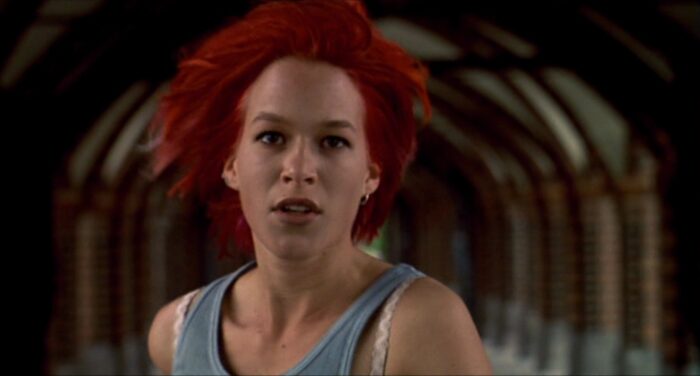
As Lola chases the money, the world widens around her as we meet a desperate range of characters in Berlin, from housewives and mothers to bankers, dubious cyclists, emergency workers, security guards, supermarket customers, police and, in a nice nod to old-fashioned slapstick, glass removers who just happen to be moving a large sheet of glass across a road as an ambulance races down it.
A wide range of the differing types of people you are likely to meet in a large city, then. But whereas in other films these characters would form obstacles in the way of Lola obtaining her goal, with their interference always being viewed in relation to how near or far Lola is from succeeding in her mission, the film takes a different route, using the nifty method of a quick-fire series of still photographs frenetically showing the journey this person’s life will take after their encounter with Lola. Using the three different attempts to get the money, Lola repeatedly bumps into the same people but encounters with each differ each time, sometimes slightly, sometimes significantly, and in each case that person’s life goes in a completely different direction.
What Run Lola Run does by utilising this method is demonstrate that its underlying philosophy is less concerned with the simple narrative points of hero goal attainment but the impact our choices and actions, whether tiny or massive, have on other people around us. This idea relates closely to a concept known as The Butterfly Effect.
The Butterfly Effect is but one part of a much larger (and I’m sure misunderstood) concept in science and mathematics known as Chaos Theory. In simple terms (and no, I’m not trying to patronise you; I need the simplicity, I assure you!), The Butterfly Effect presents the idea that “the world is deeply interconnected, such that one small occurrence can influence a much larger complex system…it evokes the idea that a small butterfly flapping its wings could, hypothetically, cause a typhoon“. When we focus on the paths Lola’s journey takes, the film does open up the possibility of the otherworldly having an impact on the actions we take in the way it proposes an interconnectedness between time, people and ideas of fate and agency.
This interconnectedness will assert itself as we see by Lola’s third attempt at getting the money how the right choices and actions at the right time connect to each other like a web and ultimately enrich Lola’s own life and get her to her goal.
Let’s take a closer look at how the film does this.
On The Clock
Time is as much a factor in Run Lola Run as the Butterfly Effect. The basic premise demands it: 20 minutes for Lola to find 100,000DM to save Manni. But there is an interconnectedness between time and the actions she takes that leads to massive consequences to her journey and to the people around her.
It’s interesting to note that the film proposes an element of fate in that Lola is always destined to meet the same people in each of her twenty-minute runs: Doris, Mrs Jäger, the Tramp, her father and Jutta, the security guard, Mike and Manni. The only deviations are in the supermarket in the first attempt and the casino in the third.
This suggests a kind of fate at play—these same people will be in the same places at the same time. Or maybe that is just a consequence of Lola starting her mission at the same point each time. In any case, as I shall explain, it is curious that Lola keeps meeting these specific people, as her interactions with each will affect her journey in different ways and will demonstrate an interconnectedness between them all, not just in simple plot terms but in how Lola learns to deal with each one and how that affects each step of her journey.
Let’s take a look at each of Lola’s three attempts and how with each one, the interconnectedness between time and Lola’s interactions spins out a wider Web of relations that gets Lola to her goal.
First Attempt
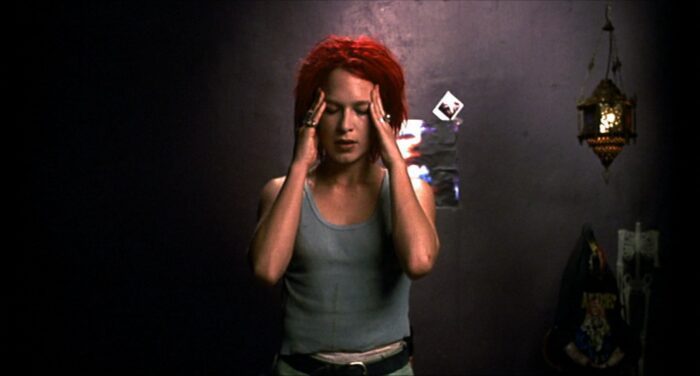
There is a basic pattern to Lola’s journey that roughly sustains throughout the three attempts: the cartoon version of Lola will encounter a boy and his dog on the stairs of her apartment block; she will run into Doris; she will encounter a group of nuns, at which point Mike will appear and try to sell Lola his bike; she will then visit her father at the bank, where he is in delicate conversation with his lover, Jutta; finally, Lola will encounter an ambulance as they speed towards a team of glass removers carrying a large sheet of glass across the street (this is just before Lola meets up with Manni).
The first attempt by Lola to obtain the money establishes this pattern/structure while demonstrating how Lola’s lack of familiarity with the same, seeing as this is her first attempt, sees her fail in her goal.
What isn’t obvious when watching the first attempt (until you watch the second) is how her initial encounters with Doris and Mike actually slow her down, thereby reducing the amount of time she has to negotiate with her father and then get to Manni. In the first attempt, a small bump into Doris is then followed by Lola encountering a group of nuns, who she chooses to run through, parting them like, well, a sea of nuns. Mike then appears on his bike, offering to sell it to Lola who is distracted by considering the question and responding ‘no’. These do not sound like particularly difficult obstacles to overcome, but this is where the film’s use of time is really effective in emphasising the interconnectedness of the events of the film. The cumulative effect of all these little events contrive to slow Lola down just imperceptibly enough that affects the point at which Lola reaches her father, and depending on what time and mood he is in determines how their reaction will resolve.
The basic scenario of Lola’s father and his lover Jutta is simple. They are having a secret conversation in his office where Jutta reveals she is pregnant. In each attempt, Lola’s father will confirm that he wants to have the baby, but what time Lola arrives after that determines in what direction the conversation will go.
In the first attempt, Lola is further slowed down by a car driven by Mr Meyer, a business associate of her father’s, who is pulling out of a courtyard and doesn’t see Lola until the last second. In the first attempt, Lola just manages to run past the car without being hit. Meyer’s reaction to this is to stare at Lola while the car is still moving, meaning he crashes into the headlight of a white car full of men with chips on their shoulders as big as their muscles. Ouch. At this point, Lola also runs past the Tramp, not realising who he is. Both of these moments will have significance in Lola’s second and third attempts.
Lola arrives at the bank as just after her father has confirmed he wants the baby with Jutta. This is important, as it stops Jutta from revealing that Lola’s father is not the father of her baby, but also the appearance of Lola, his old life and family, puts Lola’s father in a bad mood just at the point he is ready to accept a new family. Because of this, Lola’s attempt to ask him for the money is doomed. He doesn’t take her seriously and dismisses her almost as a spoilt brat. In her desperation, Lola lets loose an Earth-shaking scream, and that is the last straw for her father. He escorts her out of the office and coldly informs her that he is leaving the family and that he is not her father; her actual dad died before she was born. He also calls her a weirdo and a ‘cuckoo’s egg’ before asking the security guard to throw her out.
With that revelation, Lola’s world crumbles. The family unit she knew, albeit imperfect, was a complete sham. Her father was not her father, and he didn’t even love her in any case. While this is certainly significant from a character point of view, it becomes even more significant when we look at the bigger picture. If Lola were to arrive earlier or later, this revelation would not have been made. Lola would have been none the wiser. Therefore, it is clear that the interconnectedness of the interactions she has with strangers has an impact on time, which in turn has an impact on significant events that are to come. The Butterfly Effect here is not entirely random.
From here, there is only the ambulance to encounter. In this attempt, the driver briefly notices Lola but is still able to brake in time to avoid hitting the sheet of glass. This, however, still has a consequence for Lola: she stops to consider the near-miss she has just seen. While not significant in itself, this makes Lola late by—a minute, maybe?—for meeting Manni, who has done as he said he would and walked into the supermarket to rob it at gunpoint. Too late to turn around now. If Lola had continued running past the glass instead of staring, she might have gotten to Manni just in time and talked him into running away instead of robbing the store. Instead, Lola is taught how to take the safety off a gun—a significant point as we shall see—but is ultimately shot to death by accident by the police. All over the difference of a minute of time. “What a difference a day makes” goes the song as Lola dies. Perhaps it should have been ‘What a difference a choice makes.’
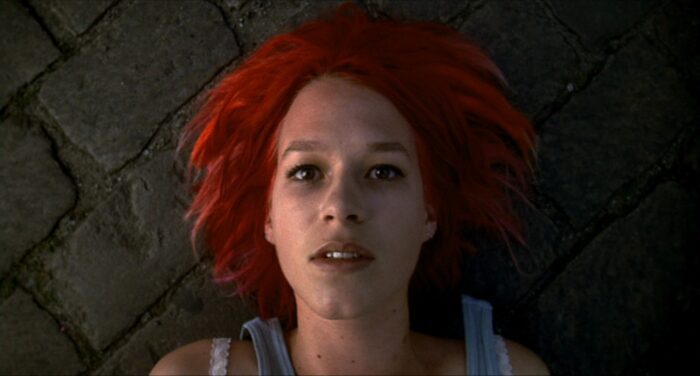
You can argue that this is just a basic plot of a film, that any hero faces obstacles which they must overcome or face tragedy. That’s just the nature of narrative storytelling. True, but as Run Lola Run disrupts this idea of narrative convention by having Lola have a further two attempts at reaching her goal by ‘restarting’ from the point of putting the phone down on Manni, effectively living her life and events again for that twenty minutes, the film demonstrates that by varying her choices, Lola has an impact of the nature of the further events she encounters, which in turn has a major effect on the conclusion to her journey. The interconnectedness of these seemingly disparate moments demonstrates then the importance and impact of our choices and actions on other elements that will affect our lives.
A comparison between the second attempt and the third attempt will demonstrate this further.
Second Attempt
The second attempt sets out its stall from the start: that an apparently inconsequential moment on the stairwell to her apartment block will considerably, physically slow her down, the lateness of her arrival to certain events having a larger, devastating impact on the end of her journey in this attempt.
In the first attempt, the cartoon Lola was confronted by a boy and his unwieldy dog who ultimately just let her pass without interference. Here, the boy decides that it would be funny to stick his leg out and trip Lola up, sending her tumbling down the stairs and hurting a leg in the process. As she begins her run, Lola is noticeably limping and moving slower than she did in the first attempt.
This in turn means that she can’t take the corner as wide and bumps harder into Doris, which would no doubt slow her down even further. This means that she arrives at Meyer’s car slightly later, his car being able to pull out of the courtyard slightly more than before. Lola has to jump onto the bonnet and off again so as to not be run down (with that bad leg? Adrenaline is a hell of a drug). That is going to do Lola any favours in turns of time and seems to slow her down even further, perhaps due to the exertion. Some things remain the same here, though: Meyer still doesn’t put the brakes on and crashes once again into the white car, this time straight into its side. This twenty minutes is still not working out well for Meyer.
Once again emphasising Lola’s slower pace compared to the first attempt, the tramp has gotten a little further down the street and Lola collides with him. This bump in the road, so to speak, further slows Lola down, as the pair exchange glances, perhaps meaningful, perhaps without realising why. If Lola only understood why, perhaps there would be no need for a third attempt (and perhaps there’d be no film!) In any case, this means Lola arrives later at the bank than before, which gives Jutta the opportunity to finish what she was saying before Lola interrupted her in the first attempt: that the baby is not Lola’s father’s. All of those insignificant encounters and bumps, while seemingly unrelated, have slowed Lola down so as not to be able to prevent Jutta’s further revelation. The web has been spun around Lola without anyone’s conscious knowledge of such.
When Lola arrives, a blazing row between her father and Jutta is underway. It is Lola witnessing this and then, putting two and two together, insulting Jutta that leads to her father slapping her. This, like the scream in the first attempt, is the catalyst for the next major action. Interestingly, the scream and the slap feel like incidences where they were reflex actions, not thought through or chosen but just done. Maybe there’s a comment in there but how the lack of discipline we have in our actions also has major consequences—where even the slightest gesture alters a person’s life, maybe it’s better to be more disciplined and considered in one’s approach to life.
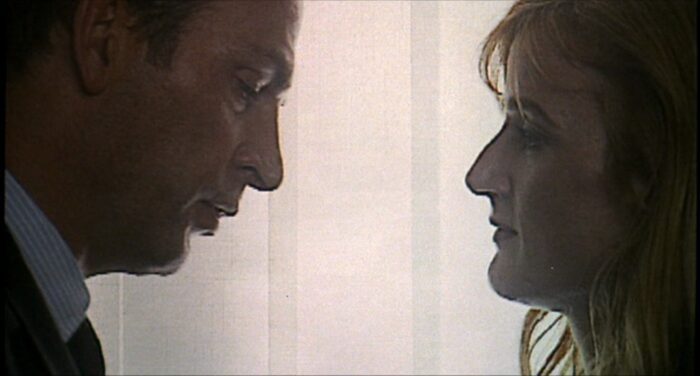
Here, though, Lola acts on impulse, stealing the security guard’s gun and forcing her father at gunpoint to give her the money from the cashier. Curious that both attempts so far have forced Lola into violence and both will see her unsuccessful in her attempt to reach her goal. Perhaps this is where the film’s moral centre really lies: that violence will only engender disaster, whether big or small. Here also is evidence of interconnectedness on a bigger scale with the different attempts, as it appears that somehow Lola has learnt from the last attempt. The security guard says, in reference to the gun she holds, “Girl, listen. You don’t know how to use that thing.” But she flicks the safety off and fires above her father’s head. No clumsiness there, unlike last time. She has, on some level, remembered her learning from the previous attempt. “Earth is a learning world”, as David Lynch has said.
With money in hand and a very narrow scrape with the police, Lola appears to be en route to having succeeded in her goal. But she has not counted on time (outside of the narrow twenty-minute time limit she is focussed on) and the interconnectedness of events. In perhaps an accidental mistake on the part of the film, even though Lola arrived here at the bank later than the first attempt and that the whole business of getting the money seems to have taken longer than getting kicked out of the bank by her father last time, Lola manages to arrive on the street with the glass before the ambulance does. Accepting that for what it is though, Lola being in front of the ambulance will cause a larger distraction for the driver, running as she is in front of the driver and then asking him for a lift. The request further distracts the driver, meaning he drives through and breaks the sheet of glass. This forces the ambulance to stop, with disastrous consequences. Somehow, Lola makes it just as Manni looks to enter the supermarket and he hears her shout. Manni turns to walk to her but the ambulance, speeding, trying to make up for lost time, doesn’t see Manni and ends up running him down, killing him.
The second attempt then as outlined above demonstrates that seemingly small interactions and choices can change the nature of our future interactions and their results. The boy tripping Lola slowed her down so that she encountered her father later, once his mood had been darkened by Jutta’s revelation of infidelity. This in turn led to Lola holding him at gunpoint for money. And yet this is all undone by Lola’s subsequent distraction of the ambulance. If Lola hadn’t run down the middle of the road, if she hadn’t distracted the driver by asking for a lift, the driver in turn wouldn’t have felt obliged to speed up and make up for lost time. While it is unfair to say that Lola killed Manni, it can be seen that via the interconnectedness of the Butterfly Effect as presented in the film that she caused a chain of events to unfurl that then resulted in his demise.
It is clear by now looking at the two attempts that the large interconnection of time, event and choice can each have an effect on the others, causing perhaps unpredictable scenarios through their interaction. What can the third attempt add to the presentation of this and can it present any conclusions through its undertaking? Let’s take a look.
Third Attempt

The seeds of Lola’s success in the Third Attempt are sown in the second when Lola remembers to click the safety off of the gun. As stated above, “Earth is a learning world” and so it would seem is the experience of repeated time. The Third Attempt is a clear demonstration of Lola, whether consciously or unconsciously, it’s never quite clear, having learnt from the ‘mistakes’ of the previous two attempts and reaching her goal successfully.
But as we shall understand, the goal ultimately is not the money, but rather to be self-aware, to understand choices have consequences and to therefore make the kindest choices that do the least damage to other people. It’s quite an Eastern theological view without any Eastern iconography or without any questioning or exploration of what this force is that is buffeting Lola from encounter to encounter and choice to choice. The focus of the film is people and through that, ultimately Lola herself. Because, by the end of the film, Lola has finally learnt and accepted her sense of agency.
The Third Attempt starts with a more-confident Lola, immediately suggesting that on some level, and it really does seem to be more sub-conscious than conscious, she remembers what she did wrong in the previous attempts and that she is going to use this knowledge to make good on her mission this time.
Remembering it was her speed that impacted her from the start of the Second Attempt, Lola begins by jumping the leg of the boy on the stairwell and barking back at the dog, forcing them both to cower. She takes the corner and misses Doris entirely, meaning Doris is not hurt or annoyed (well, less annoyed anyway) and Lola is not slowed down. She chooses not to run through the nuns this time, again remembering this as an obstacle, and runs around them. She does nearly run into Mike, but it’s notable that Lola says sorry to Mike here. She said sorry to Doris in the Second Attempt and it didn’t seem to make much difference, but here, rather than ignoring Mike or accusing him of having a stolen bike, the apology from Lola seems to influence Mike’s fate on a micro level.
Whereas previously, Mike had been shown, through the photo flashbacks, as either being snatched off his bike and beaten up or becoming a down-and-out needle user, the immediate consequence here is that Mike leaves his encounter with Lola unharmed (as far as we know for the future anyway) and stops at a cafe stand where he just so happens to meet the tramp showing off his money. Mike is astute enough to sell his bike off at an increased 70 marks than the 50 he quoted Lola, but the fact that the tramp has a bike now means his cycling takes him away from Lola, who he, therefore, doesn’t bump into. This means Lola is not slowed down but also that the tramp can cycle faster and further than he was able to walk and this is what brings him to Manni, who ultimately chases him down and gets his money back.
From this simple act of apology, a form of kindness, Lola has spun off a new chain of events which will lead Manni to save his own life and claim the money back. But as we said before, the money is a MacGuffin and besides, Lola doesn’t know any of this yet. She still believes she needs to get the money but instead, she will attain something much more valuable.
Lola meets Mr Meyers’s car pulling out of the courtyard, but this time, she leaps onto the bonnet and lies there staring at Meyers. This causes Meyers to break, something he didn’t do in the previous attempts. The white car drives past and there is no collision. Lola seems to have remembered on a sub-conscious level that Meyers has previously crashed (she must have heard the crashes last time behind her, she couldn’t have run that far away) and through her agency, by choosing to force his car to brake, she has saved Meyers’ life.
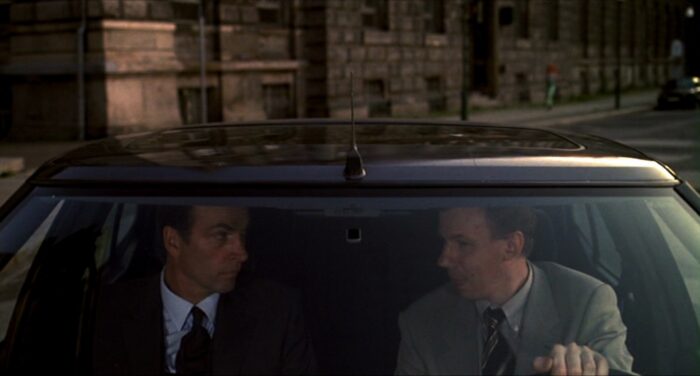
This frees Meyers up to reach his destination: the bank. Again, Lola’s father says he wants to have the baby with Jutta but before Jutta can say more, the secretary announces Mr Meyers is here to collect Lola’s Dad. Jutta tries to reveal her further revelation but Lola’s father stops her and says they will speak later. He is in a very good mood and is happy, but also Lola’s intervention in preventing Meyers from crashing has presented a situation where Meyers actually arrives at his meeting and does not have the opportunity to have an argument with Lola or to be given bad news. Lola just misses him at the bank, but the situation created will lead to a powerful moment between father and daughter very shortly.
For now, the two threads Lola has created by apologising to Mike and saving Meyers are about to entwine, their interconnectedness having major consequences. As Manni chases the tramp across town, Meyers is driving Lola’s father to some undisclosed location that seems work-related. But the one soon impacts the other: the tramp cycles out suddenly into the road and Manni follows, both of them running out in front of Meyers’ car, forcing him to swerve and crash into the white car he previously crashed into! This is only one of a couple of times the film insinuates there might be direct fate at play: maybe Meyers’ car was always meant to crash into the white car but in this attempt, it was just delayed, prolonged. It’s not a thread the film pulls at, preferring to focus on the consequences of choices, but it does mean Lola’s dad is seriously injured in the crash though.
Having missed her father at the bank, what with him having already left, Lola is at a loss until the security guard arrives. He says, almost as a throwaway comment, “You’ve finally arrived, dear”. It triggers something in Lola, some kind of understanding that is never really elaborated but the intensity of her stare is enough to make the security guard look like he is about to wilt. He appears to be learning something from her stare too but he does not know what. It’s an eerie moment and again raises a question about what forces are at play here.
Yet, for all the strange supernaturalness of the scene, it can also be read as a further awakening of Lola’s agency, an awareness that she needs to make things happen. She continues to run and there’s a moment where she does seem to lean back on fate for a moment, thinking as she runs: “Come on. Help me. Please. Just this once. I’ll just keep running, okay? I’m waiting. I’m waiting. I’m waiting. I’m waiting”. It brings up an interesting conflict between fate and agency, and it’s fate that initially delivers—a lorry brakes as Lola runs across the road. This forces Lola to stop and in doing so, she spies the casino which is going to bring her the money she thinks she still needs to save Manni. Fate has done well.
And yet it is agency that wins out. Fate might have brought her to the place, but Lola needs to do the work. As the bouncer tries to quietly get Lola to leave because of the inappropriateness of her attire, she turns to him and says with such powerful, quiet conviction, “Just one more game”. Again, the supernatural stare works its power to the quiet alarm of the bouncer, the force of Lola’s will seemingly convincing the bouncer through some sort of intangible energy to let her play. What follows is the return of Lola’s scream from the first attempt, but this time it seems to be cancelled, purposefully used. Lola has somehow used the power she finds in herself to directly influence events to her desired outcome. The scream is physically and purposefully directed at the roulette table and is so powerful that it physically alters the path of the ball and miraculously lands it in black 20 on the roulette table—the exact number and colour Lola has bet on.
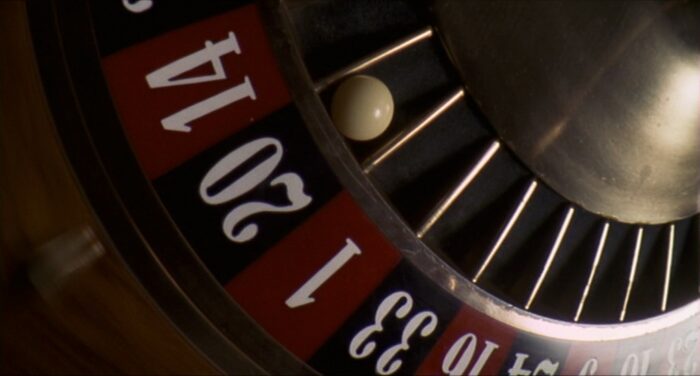
What power does Lola have, that we all have maybe, to alter events? the sheer focussed intensity of will? This is, of course, not necessarily a Nietzschean ‘Will to Power’ thing, but it does seem to suggest the positives and desirable effects of being aware of and utilising our own agency—that we cannot always predict what impact our choices will have on the universe, but if we are more aware of this and choose more discerningly and carefully, we are more likely to generate a positive outcome.
This emphasis on agency is the real point of the film and is made explicit by the final moments before Lola reaches Manni. As Lola runs across town from the casino, the ambulance is actually in front of her this time. This means the driver is not distracted and brakes in time for the glass so as not to break it. It also means Lola has enough time to realise hopping a lift in the ambulance might save time (however inappropriate jumping into the back of a random ambulance might be!).
But the sequene does more than that. The man having his chest pumped in the back of the vehicle is her father. Her father can’t show recognition on his face other than to share a meaningful look with Lola but he reaches out his hand and she takes it. The moment, of the possible loss of her father, clearly upsets Lola. She tells that medical worker “I’ll stay with him”. They sit holding hands and looking meaningfully at each other and it is the comfort of this that actually stabilises her father’s heartbeat, to the amazement of the medical worker.
That it should take this event to reconcile father and daughter is tragic, and we don’t know if Lola’s dad makes it, but the bigger result here is that at least there is a reconciliation and that Lola will never know the truth that her ‘father’ is not her biological. Is it honest? No. Is it kinder to Lola? Yes, and that arguably is the better result. When you consider that the larger bulk of the film’s scenes focus on the encounters and the relationship between father and daughter, this is the real conclusion of Lola’s journey. Kinder choices can lead to a situation where reconciliation is possible. And with this and a sense of agency, we can safely assume that Lola has become a stronger, more whole person because of it. That is Lola’s real end goal and the film’s real message—and to my mind, it’s truly beautiful.
Conclusion
We have clearly seen how Run Lola Run uses ideas and elements from the Butterfly Effect and from concepts of fate and agency to demonstrate how our choices, however big and small, have a much wider impact on people’s lives whether close or distant from us. The film proposes that by being aware of the power of our own agency, however limited that might actually be, we can become more conscious of the choices we make and therefore by being kinder we can protect and reconcile with the ones we love, becoming stronger and perhaps more empathetic people because of it. It’s a beautiful concept and all the more necessary now in a world where concepts of toxicity and constant conflict are even more embedded, in part thanks to the internet and the social media bubble that has become ever more prevalent. We need to be more conscious of our choices and we need to be kinder. Run Lola Run demonstrates that beautiful things come out of such a philosophy, and it’s to the film’s credit that it does not push a specific religious or theological angle on to its viewers, instead focusing on the people and by doing so reaching as large an audience as possible with its message.
Before we go, I would like to take a last look at Lola and Manni, that beautifully innocent couple, as we say goodbye to them in the film and the film puts its full stop on its message.
When Lola finally turns up at the phone booth, there is no Manni. To her amazement, she sees him come out of Ronnie’s car. Job done. Manni has handed over the reclaimed money and is now safe. Manni will never know it, he will always think he saved himself by finding the tramp by chance and liberating the money. But that was only possible, unknown to both Lola and Manni, by the chain of events she triggered. In an earlier flashback, Lola said she would never let Manni die. Well, here she certainly kept her promise and kept Manni alive. Her kindness and her agency determined it. As Manni asks “What’s in the bag?”, the now-superfluous money puts the full stop to the story. With this money, the pair can possibly make a fresh start without having to worry about how to live, at least for a little while. They will need to make the right choices, though. Out of all three attempts Lola made, this is the best of all possible worlds. Not perfect by any means. But best.





Great article and love this film. Only issue, the man in thr ambulance is NOT Lola’s father but the security guard. In the third attempt when Lola arrives at the bank you hear his heartbeat and him clutching his chest. Plus in attempt 2 she held up the bank at gunpoint that could’ve easily caused him to have a hear attack. This makes these little acts of kindness all the more important that Lola is there for the security guard in the ambulance to give him comfort.